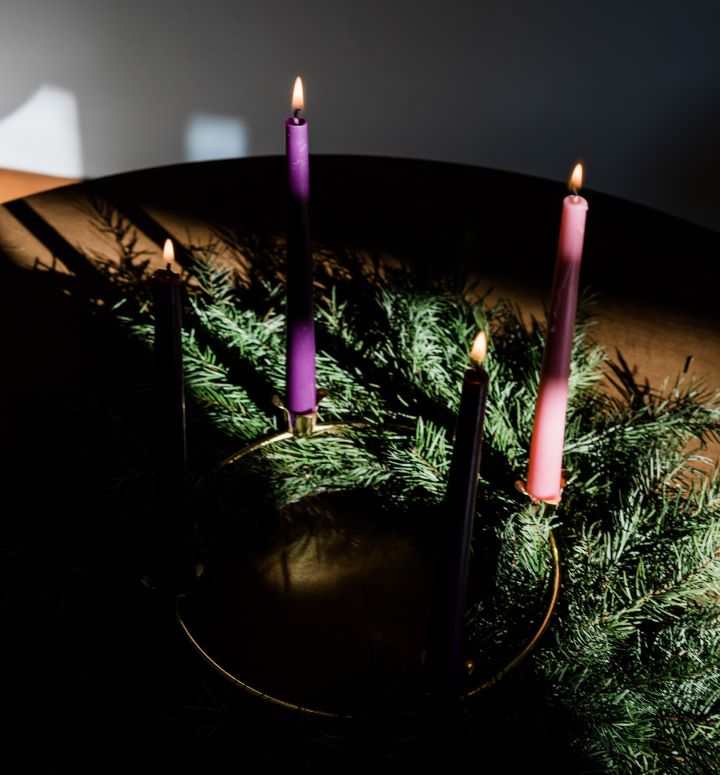The Catholic Church celebrates several liturgical seasons throughout the year. My favorite is the season of Advent in the weeks before Christmas because Advent is a time for hope.
A Review of Church Seasons
The Church year begins at the end of November or early December. This year it begins on December 3.
Advent: Advent is a time for hope and waiting for Jesus at Christmas. The season lasts four weeks.
Christmas: Christmas celebrates Jesus’ birth.
Ordinary Time: The first period lasts four to eight weeks after Christmas until the beginning of Lent on Ash Wednesday. Ordinary does not mean “ordinary” in the way we normally understand it. In this context, it means “counted time.”
Lent: This is a six-week time of penance (prayer, fasting, and almsgiving) in preparation for Easter.
Triduum: Triduum means “three days.” These are Holy Thursday, Good Friday, and Holy Saturday.
Easter: The Easter season begins at the Vigil Mass for Easter on Holy Saturday evening and continues until Pentecost, the coming of the Holy Spirit on the Apostles.
Ordinary Time (until Advent the next year) This period of Ordinary Time lasts for six months between Pentecost and the first Sunday of Advent.
Suffering: The World, our Lives
Suffering is part of our lives as human beings and some communities suffer more than others. Suffering can be the result of human choices or because of natural disasters: drought, excess rain, heat, illness, and so on.
In this century, the current level of poverty is unacceptable. Warfare is far too common. Whether people or nature is the cause of misery, human beings have not come together to solve these problems.
Each of us faces suffering too. Suffering could come from loss, disease or illness in us or loved ones, loss of employment, loneliness, poverty, and so on.
The experience of darkness is real. I love Advent because it is a time for hope.

Advent is Hopeful Waiting
In the Catholic lectionary, the Sunday and daily readings during Advent are beautiful. They have hopeful messages, primarily from the prophet Isaiah but also from Genesis, Sirach, Zechariah, Jeremiah, Judges, the Song of Songs, 1 and 2 Samuel, Malachi. All help us see what a world would look like if people lived as God wished: the Kingdom of God. These are excerpts from several readings.
“They shall beat their swords into plowshares and their spears into pruning hooks; One national shall not raise the sword against another, nor shall they train for war again.” (Isaiah 2:4)
“Then the wolf shall be a guest of the lamb, and the leopard shall lie down with the kid” (Isaiah 11:6)
“The Lord GOD will wipe away the tears from all faces; The reproach of his people he will remove from the whole earth; for the LORD has spoken.” (Isaiah 25:8)
“Comfort, give comfort to my people, says your God. Speak tenderly to Jerusalem, and proclaim to her that her service is at an end; her guilt is expiated.” (Isaiah 40:2)
A Time of Hope
I experience hope and joy from these beautiful readings They illustrate the Kingdom of God. I believe that the world’s people can be better. I can be better. I find myself asking, “Where does Jesus most need to be born in the world today? Where will he be born anew? Also, “What part of my life needs Jesus to be born?”
Christians light an Advent wreath to celebrate the movement from week to week during Advent. Traditionally, three candles are purple and one is pink. Advent used to be a time of penance much like Lent with purple symbolizing this penance. The pink Sunday candle is lit on the third Sunday of Easter, “Gaudete Sunday,” from the Latin word for “rejoice.” We rejoice because we are close to Jesus’ birth!
A candle in a dark room is a symbol of hope for me. The darkness may represent suffering in the world or areas of my own life that feel dark. The candle is the hope that the light of Christ can dispel that darkness. Advent truly is a time for hope.













